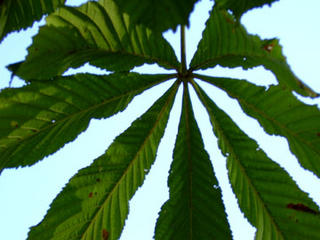We used to go for walks along the banks of the river Clyde with my dad when it was time to collect conkers [also known as chessies]
Huge chestnut trees grew very close to the river, some of whose trunks were hollowed out enough to fit a child inside - and some are still there even now, though a couple have been chopped down. The felled trees are probably the ones which were hollow 30 years ago.
My dad carried a special heavy conker collecting stick with him and i seem to remember that this stick had once belonged to his father - though i'm not sure if it had always been used to collect horse chestnuts.
When we got to the trees my dad would tell us to "stand well back" and then throw the stick high up into the tree - my sisters and i always held our breath as it seemed that the time between the throwing of the stick and it crashing to the ground was some sort of suspended time. The stick always seemed to hesitate at the top of the tree; as if deciding whether or not to return to land.
Eventually it would crash through the branches, knocking down the chestnuts. We would then run over and try not to prick our hands too much on the spiky green casings as we separated the pieces of 'shell' and reveal the glossy brown nut inside.
We filled our pockets with as many of the nuts as we could , until we returned home, pockets bulging.
Then at the kitchen table we'd sit with a knitting needle and some string or old shoe laces and pierce the nut through the middle and suspend it on the cord. Then we were ready to do battle!
The battles involved hitting at another persons strung conker with one's own. Its difficult to explain the magic of this game to people as it probably seems quite odd. However, kids used to love it. The strongest conker -ie the one which survived the battle could often go on to beat a succession of other conkers. Some people would use secret remedies involving slow cooking or soaking in vinegar or milk in order to try and toughen their conker so it would eventually become a champion in the playground.
Playing conkers is now banned in some UK school playgrounds -which seems sad as there was never any violence associated with the game when we played it and the only injury was the occasional whack on the knuckles. I seem to remember the excuse was something about flying pieces being dangerous if they landed in someone's eye - but somehow we and our parents and grandparents managed to avoid this.
The sky seen through a growing chestnut leaf - the chestnut tree is growing near Antibes Station and all these photos were taken in the previous couple of days.

A large cluster of chestnuts on the tree - I think there are seven in this cluster. It was growing right at the top of the tree so it was a struggle to take this photo.
 A single chestnut
A single chestnut A chestnut on the ground - the case just starting to split. In Scotland , it was difficult to find decent chestnuts on the ground as the grass was always so wet and the nuts would rot quite quickly. The nuts are not edible.
A chestnut on the ground - the case just starting to split. In Scotland , it was difficult to find decent chestnuts on the ground as the grass was always so wet and the nuts would rot quite quickly. The nuts are not edible.
Another chestnut -a bit more of the nut showing

A nut released from its shell = the colour of these nuts is indescribable - a reddish brown that almost sucks you in with its intensity - its why the chestnut colour has its name.

Some of the chestnut leaves on the ground

A close up of the centre of a fallen leaf

BTW My dad's conker stick eventually decided to stay in the chestnut tree, around the time i went conkering for the last time when i was a teenager.
chestnut
conker
nuts
photos




6 comments:
You brought back so many memories for me. I remember playing conkers too - and all the schemes kids used to talk about in the playground to harden them for competition.
I remember referring to your best conker by the number of victories - "this is my 25'er", and friends gathering round to see your best conker with a hushed awe in the air.
Conkers are one of those things that make childhood seem so halcyon.
There were all sorts of tips and tricks for making your conker better, including baking, soaking in vinegar and, rather bizarrely, passing through the digestive tract of a pig.
There was also a local myth about a horse chestnut tree that had a blacksmith anvil buried beneath it, thus making extra special conkers.
Fond, fond memories.
Great pics....I never knew how these nuts came to be. Wonderful story about your dad.
=^..^=
Superb split open chestnut photos. For some reason the second one reminds me of a venus flytrap!
Do you remember "clackers" the manufactured plastic version of playing conkers, now they really could get quitw scary!
Alison -- did you see the photo I posted on my blog earlier this month of an open chestnut with an insect on it? It's a different kind of chestnut -- the outer shell looks fuzzy rather than spiky -- but feels spiky. I think our tree is called Edible Chestnut but I don't know anything else about it. I bet you do, though!
Andrea,
They call them Sweet Chestnuts
Post a Comment